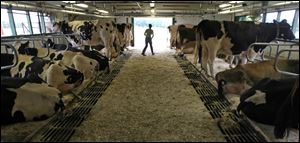
Ag schools trim dairy herds as costs increase
7/13/2010
Student Amanda Grieco stops to kiss a Jersey cow during chores at a University of Vermont dairy barn.
Toby Talbot / AP
BURLINGTON, Vt. - The fields and red barns at the University of Vermont soon will house fewer cows. The university is selling its herd because of low milk prices, high costs, and budget cuts.
Other universities are looking for ways to cut costs because of high feed, fuel, and labor prices.
The sales are occurring despite growing enrollment in agriculture programs. The herds mainly are for faculty research.
The University of Vermont plans to sell its 255 Holsteins and have faculty work on private farms that could be paid $20,000 a year for three years, said Tom Vogelmann, dean of UVM's College of Agriculture and Life Sciences. Farmers would get extra cash and researchers would have access to more cows that are likely to be in more modern facilities.
"We're really excited because we feel that this is really a new model that land-grant institutions can work toward," Mr. Vogelmann said.
Most land-grant universities face similar challenges, he said, as the cost of keeping animals rises faster than milk prices or state funding.
A minority of schools is discontinuing the herds, but all institutions are studying the costs of the animals' upkeep, said Jim Linn, vice president of the American Dairy Science Association.

The black-and-white Holstein cows in this University of Vermont dairy barn are among 255 to be sold.
"It is a major cost, and we try and offset some of those costs through research and teaching dollars, but again, it's more costly than plant sciences," said Mr. Linn, department head for animal science at the University of Minnesota. Like Michigan State University, it is selling one of three herds.
Cows will go on the auction block at the University of Kentucky, which hopes to reduce its herd from about 140 animals to about 100 by September. Squeezed by low milk prices and upkeep, the school too has run out of room to spread manure as other agriculture programs expand, said Nancy Cox, director of the Kentucky Agricultural Experiment Station and associate dean for College of Agriculture.
Kentucky wanted to move its herd to a facility at Eastern Kentucky University, but money isn't available to build it, Ms. Cox said.
"We are losing money," she said. "While the universities aren't into dairying to make money, many sell their milk to try to recoup some of their costs."
States have been cutting funds for land-grant universities for about 20 years or more, Paul Hassen of the Association of Public and Land-Grant Universities said. That has accelerated with state budget woes.
Rutgers University, facing the same challenges, combined its herd with one at a dairy facility at the University of Delaware about eight years ago. It now raises their offspring. Rutgers researches heifers' behavior, and when the animals are old enough to produce calves, they are moved to Delaware, which specializes in dairy production research.